Fast read
Virtually all modern solar battery systems in Australia can be remotely monitored and updated by the manufacturer. This standard feature allows for performance tracking, diagnostics, and essential software updates for improved functionality and safety. While this offers significant benefits, it is important to understand how your data is used and the security measures in place.
Can a battery system be remotely monitored and updated by the manufacturer?
In today’s connected world, it’s almost unthinkable to install a sophisticated piece of technology like a home battery without the ability to monitor and manage it remotely. For manufacturers, this access is essential for maintaining the health, safety, and performance of their products deployed across the country.
Remote capabilities allow manufacturers and, with your permission, installers to:
- Monitor System Health: They can track the performance of your battery in real-time, watching for any signs of trouble. This includes monitoring battery state of charge, temperature, and power flows.
- Diagnose Faults: If an issue arises, technicians can often diagnose the problem remotely without needing to visit your home. This leads to quicker resolutions and less downtime.
- Deploy Firmware Updates: Technology is constantly evolving. Manufacturers push out over-the-air (OTA) software updates to improve your battery’s performance, add new features, or apply critical safety patches.
- Optimise Performance: Some advanced systems use AI to analyse your energy usage patterns and optimise the battery’s charging and discharging cycles to maximise your savings.
For you as the homeowner, this connectivity usually comes with a user-friendly app for your smartphone or computer. These apps provide a clear window into your home’s energy ecosystem, allowing you to see your solar production, battery status, and household consumption at a glance.
How do manufacturers monitor and update systems?
Your battery system connects to the internet via your home’s Wi-Fi network or sometimes a built-in cellular connection. This connection allows the system’s Energy Management System (EMS) to communicate with the manufacturer’s secure cloud-based platform.
- For Monitoring: The system regularly sends operational data to the manufacturer’s servers. This isn’t just about your overall energy use, but detailed metrics on the battery’s internal functions.
- For Updates: When an update is available, the manufacturer can push it directly to your system. This process is often automatic, ensuring your battery is always running the latest and most secure software. Some systems or updates may require your approval before installation.
A good example of this is the Tesla Powerwall, which receives regular over-the-air software updates to add new features and improve functionality, all managed through the Tesla app. Similarly, brands like Sungrow use their iSolarCloud platform to provide detailed monitoring and allow users and installers to adjust settings, such as setting a reserve battery capacity for blackouts or scheduling charging from the grid during off-peak times. More advanced all-in-one systems, like the Sigenergy SigenStor, leverage AI in their mobile app to provide smart insights and optimise energy management based on your specific usage patterns.
What about data privacy and system security?
Allowing remote access to a core component of your home’s energy system naturally raises questions about privacy and security. It’s a valid concern—after all, energy consumption data can reveal a lot about your daily routines.
Here’s what you need to know:
- Data Usage: Manufacturers primarily use this data for the reasons mentioned above: diagnostics, performance monitoring, and system improvement. Reputable companies have clear privacy policies that outline what data is collected and how it is used.
- User Control: You, as the system owner, have control. You can typically decide who has access to your data. While the manufacturer will almost always require a connection for warranty and safety purposes, you can usually grant or revoke access for your installer.
- Cybersecurity: With any internet-connected device, there is a risk of cyberattacks. Manufacturers invest in cybersecurity measures to protect their systems from unauthorised access. This includes data encryption and secure cloud infrastructure. As a user, ensuring your home Wi-Fi network is secured with a strong password is a crucial first step.
Research in Australia has highlighted that homeowners value transparency and control over their data, especially when participating in programs like Virtual Power Plants (VPPs) where a third party can control the battery. Trust in the provider is paramount.
Can you opt out of remote monitoring?
In most cases, opting out completely is not practical or recommended. The connection is integral to the battery’s warranty, safety, and long-term performance. Refusing the connection could mean:
- Voiding Your Warranty: Manufacturers often make warranty coverage conditional on the system being connected so they can monitor its health and ensure it’s operating within safe parameters.
- Missing Critical Updates: You would miss out on essential firmware updates that could improve efficiency, compatibility, or, most importantly, address potential safety issues.
- Slower and Costlier Maintenance: Without remote diagnostics, every minor issue would require a physical visit from a technician, leading to delays and increased costs.
Instead of opting out, the better approach is to engage with your installer. Ask them to walk you through the privacy settings and show you how to manage access permissions through the system’s app.
Questions to ask your installer
Before your battery system is installed, have a clear conversation with your installer, who should be accredited by Solar Accreditation Australia (SAA). The Clean Energy Regulator appointed SAA as the new accreditation body on 29 February 2024, taking over this role from the Clean Energy Council (CEC), a name many consumers still recognise.
- “Can you show me the monitoring app and what information I will be able to see?”
- “What are the manufacturer’s policies on data privacy?”
- “What level of access will you, as the installer, have to my system after installation?”
- “Can I manage or revoke your access in the future if I choose to?”
- “How are firmware updates managed, and will I be notified?”
Your energy data, your control
Ultimately, a connected battery is a smarter, safer, and better-performing battery. The ability for a manufacturer to monitor and update your system is a powerful feature designed to protect your investment and ensure it operates efficiently for years to come. By understanding how it works and taking an active role in managing your data, you can enjoy the significant benefits of this technology with confidence and peace of mind.




